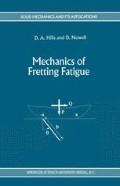Abstract
In the design of any mechanical structural component, two criteria play very important parts. These are: the avoidance of yield, and the avoidance of brittle fracture. It is relatively easy to design against yield; this simply requires the determination of a composite stress parameter from the individual stress components, and this parameter is maintained below the value of the yield stress at all points. Design against brittle fracture is more difficult; this requires not only the determination of the state of stress within an object, but also some speculation on the form, location, and origin of initial defects, which often grow by the process of fatigue during the service life of the component, and may reach a critical value leading to brittle fracture. This latter criterion forms the basis of the study of fracture mechanics. There is now an excellent range of introductory textbooks on this subject, such as those by Gdoutos (1990, 1993), Ewalds and Wanhill (1984), and Broek (1982, 1989). It is important to recognise at the outset that the fatigue life of a crack has two quite distinct elements, and that the relative proportion of the total life expended in each portion will vary tremendously. These two phases are the initiation or nucleation phase, and the propagation stage. In welded structures, or those components made from castings of indifferent quality there will pre-exist a number of defects of appreciable size, due to the presence of inclusions, slag, or lack of weld penetration. In these components there is no initiation time, so that the entire life of the component is expended in propagation. However, most critical components in high-technology applications are not manufactured by these routes, and the surface finish is usually very good. There are therefore no pre-existing macroscopic defects, and it is very difficult to speculate where they may form. Indeed, it is the designer’s job to ensure that the geometry of the components is such as to reduce the chances of initiation to a minimum! This is normally done by avoiding stress raisers such as fillets, keyways, screw threads and abrupt changes of section. All these measures are concerned with keeping the stress state as uniform as possible, and are successful when the possible sites of initiation lie on a free surface. However, where there is a connection between two components, such as a collar heat shrunk onto a shaft, another form of crack initiation, which is much more aggressive than that prevalent at a free surface becomes possible. This is the phenomenon of fretting.

Close-up photograph of fretting damage on a mild steel shaft used to support steel blocks in a fatigue apparatus.
Access this chapter
Tax calculation will be finalised at checkout
Purchases are for personal use only
Preview
Unable to display preview. Download preview PDF.
Author information
Authors and Affiliations
Rights and permissions
Copyright information
© 1994 Springer Science+Business Media Dordrecht
About this chapter
Cite this chapter
Hills, D.A., Nowell, D. (1994). Introduction. In: Mechanics of Fretting Fatique. Solid Mechanics and Its Applications, vol 30. Springer, Dordrecht. https://doi.org/10.1007/978-94-015-8281-0_1
Download citation
DOI: https://doi.org/10.1007/978-94-015-8281-0_1
Publisher Name: Springer, Dordrecht
Print ISBN: 978-90-481-4409-9
Online ISBN: 978-94-015-8281-0
eBook Packages: Springer Book Archive

